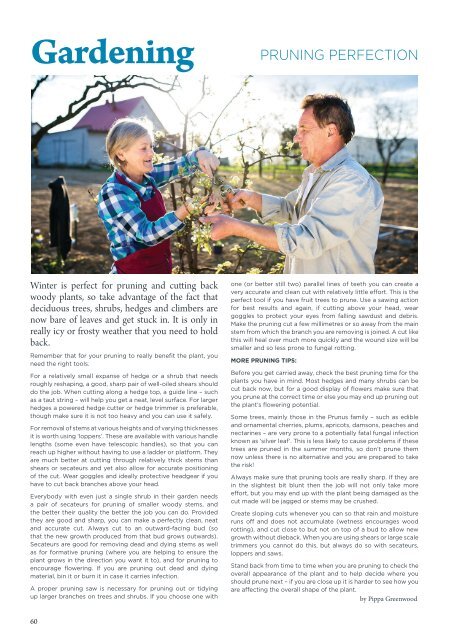I and A Mag Jan20
Telford Magazine
Telford Magazine
Create successful ePaper yourself
Turn your PDF publications into a flip-book with our unique Google optimized e-Paper software.
Gardening<br />
PRUNING PERFECTION<br />
Winter is perfect for pruning <strong>and</strong> cutting back<br />
woody plants, so take advantage of the fact that<br />
deciduous trees, shrubs, hedges <strong>and</strong> climbers are<br />
now bare of leaves <strong>and</strong> get stuck in. It is only in<br />
really icy or frosty weather that you need to hold<br />
back.<br />
Remember that for your pruning to really benefit the plant, you<br />
need the right tools.<br />
For a relatively small expanse of hedge or a shrub that needs<br />
roughly reshaping, a good, sharp pair of well-oiled shears should<br />
do the job. When cutting along a hedge top, a guide line – such<br />
as a taut string – will help you get a neat, level surface. For larger<br />
hedges a powered hedge cutter or hedge trimmer is preferable,<br />
though make sure it is not too heavy <strong>and</strong> you can use it safely.<br />
For removal of stems at various heights <strong>and</strong> of varying thicknesses<br />
it is worth using ‘loppers’. These are available with various h<strong>and</strong>le<br />
lengths (some even have telescopic h<strong>and</strong>les), so that you can<br />
reach up higher without having to use a ladder or platform. They<br />
are much better at cutting through relatively thick stems than<br />
shears or secateurs <strong>and</strong> yet also allow for accurate positioning<br />
of the cut. Wear goggles <strong>and</strong> ideally protective headgear if you<br />
have to cut back branches above your head.<br />
Everybody with even just a single shrub in their garden needs<br />
a pair of secateurs for pruning of smaller woody stems, <strong>and</strong><br />
the better their quality the better the job you can do. Provided<br />
they are good <strong>and</strong> sharp, you can make a perfectly clean, neat<br />
<strong>and</strong> accurate cut. Always cut to an outward-facing bud (so<br />
that the new growth produced from that bud grows outwards).<br />
Secateurs are good for removing dead <strong>and</strong> dying stems as well<br />
as for formative pruning (where you are helping to ensure the<br />
plant grows in the direction you want it to), <strong>and</strong> for pruning to<br />
encourage flowering. If you are pruning out dead <strong>and</strong> dying<br />
material, bin it or burn it in case it carries infection.<br />
A proper pruning saw is necessary for pruning out or tidying<br />
up larger branches on trees <strong>and</strong> shrubs. If you choose one with<br />
one (or better still two) parallel lines of teeth you can create a<br />
very accurate <strong>and</strong> clean cut with relatively little effort. This is the<br />
perfect tool if you have fruit trees to prune. Use a sawing action<br />
for best results <strong>and</strong> again, if cutting above your head, wear<br />
goggles to protect your eyes from falling sawdust <strong>and</strong> debris.<br />
Make the pruning cut a few millimetres or so away from the main<br />
stem from which the branch you are removing is joined. A cut like<br />
this will heal over much more quickly <strong>and</strong> the wound size will be<br />
smaller <strong>and</strong> so less prone to fungal rotting.<br />
MORE PRUNING TIPS:<br />
Before you get carried away, check the best pruning time for the<br />
plants you have in mind. Most hedges <strong>and</strong> many shrubs can be<br />
cut back now, but for a good display of flowers make sure that<br />
you prune at the correct time or else you may end up pruning out<br />
the plant’s flowering potential.<br />
Some trees, mainly those in the Prunus family – such as edible<br />
<strong>and</strong> ornamental cherries, plums, apricots, damsons, peaches <strong>and</strong><br />
nectarines – are very prone to a potentially fatal fungal infection<br />
known as ‘silver leaf’. This is less likely to cause problems if these<br />
trees are pruned in the summer months, so don’t prune them<br />
now unless there is no alternative <strong>and</strong> you are prepared to take<br />
the risk!<br />
Always make sure that pruning tools are really sharp. If they are<br />
in the slightest bit blunt then the job will not only take more<br />
effort, but you may end up with the plant being damaged as the<br />
cut made will be jagged or stems may be crushed.<br />
Create sloping cuts whenever you can so that rain <strong>and</strong> moisture<br />
runs off <strong>and</strong> does not accumulate (wetness encourages wood<br />
rotting), <strong>and</strong> cut close to but not on top of a bud to allow new<br />
growth without dieback. When you are using shears or large scale<br />
trimmers you cannot do this, but always do so with secateurs,<br />
loppers <strong>and</strong> saws.<br />
St<strong>and</strong> back from time to time when you are pruning to check the<br />
overall appearance of the plant <strong>and</strong> to help decide where you<br />
should prune next – if you are close up it is harder to see how you<br />
are affecting the overall shape of the plant.<br />
by Pippa Greenwood<br />
60










